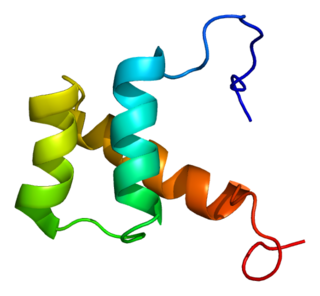
Flavin-containing monooxygenase 3 (FMO3), also known as dimethylaniline monooxygenase [N-oxide-forming] 3 and trimethylamine monooxygenase, is a flavoprotein enzyme (EC 1.14.13.148) that in humans is encoded by the FMO3 gene. This enzyme catalyzes the following chemical reaction, among others:

Dimethylaniline monooxygenase [N-oxide-forming] 1 is an enzyme that in humans is encoded by the FMO1 gene.

Dimethylaniline monooxygenase [N-oxide-forming] 5 is an enzyme that in humans is encoded by the FMO5 gene.

Sulfhydryl oxidase 1 is an enzyme that in humans is encoded by the QSOX1 gene.

60S ribosomal protein L36a is a protein that in humans is encoded by the RPL36A gene.

39S ribosomal protein L28, mitochondrial is a protein that in humans is encoded by the MRPL28 gene.

Hypermethylated in cancer 2 protein is a protein that in humans is encoded by the HIC2 gene.

Cytochrome P450 2F1 is a protein that in humans is encoded by the CYP2F1 gene.

Homeobox protein DLX-2 is a protein that in humans is encoded by the DLX2 gene.

Dimethylaniline monooxygenase [N-oxide-forming] 4 is an enzyme that in humans is encoded by the FMO4 gene.

39S ribosomal protein L39, mitochondrial is a protein that in humans is encoded by the MRPL39 gene.

39S ribosomal protein L20, mitochondrial is a protein that in humans is encoded by the MRPL20 gene.

Protein Jade-3 is a protein that in humans is encoded by the PHF16 gene.

28S ribosomal protein S6, mitochondrial is a protein that in humans is encoded by the MRPS6 gene.

Zinc finger protein 19 is a protein that in humans is encoded by the ZNF19 gene.

RCC1 and BTB domain-containing protein 2 is a protein that in humans is encoded by the RCBTB2 gene.

Voltage-dependent calcium channel gamma-4 subunit is a protein that in humans is encoded by the CACNG4 gene.

Armadillo repeat-containing X-linked protein 1 is a protein that in humans is encoded by the ARMCX1 gene.

28S ribosomal protein S21, mitochondrial is a protein that in humans is encoded by the MRPS21 gene.

The flavin-containing monooxygenase (FMO) protein family specializes in the oxidation of xeno-substrates in order to facilitate the excretion of these compounds from living organisms. These enzymes can oxidize a wide array of heteroatoms, particularly soft nucleophiles, such as amines, sulfides, and phosphites. This reaction requires an oxygen, an NADPH cofactor, and an FAD prosthetic group. FMOs share several structural features, such as a NADPH binding domain, FAD binding domain, and a conserved arginine residue present in the active site. Recently, FMO enzymes have received a great deal of attention from the pharmaceutical industry both as a drug target for various diseases and as a means to metabolize pro-drug compounds into active pharmaceuticals. These monooxygenases are often misclassified because they share activity profiles similar to those of cytochrome P450 (CYP450), which is the major contributor to oxidative xenobiotic metabolism. However, a key difference between the two enzymes lies in how they proceed to oxidize their respective substrates; CYP enzymes make use of an oxygenated heme prosthetic group, while the FMO family utilizes FAD to oxidize its substrates.
















